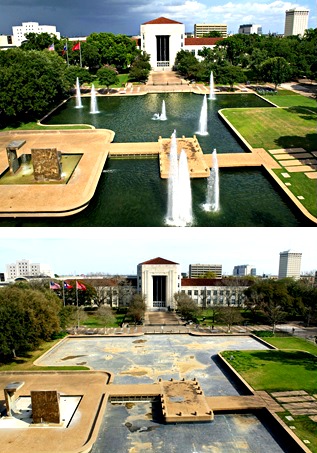 |
A chain-link fence surrounds the outer edge of perhaps the most iconic feature of the University of Houston campus: the Cullen Family Plaza Fountain and Reflecting Pool.
The construction barrier has been in place since December, when the spray jets were turned off and the 200,000 gallons of water were drained. Since then, the fountain has sat quietly and patiently, waiting for the overhaul it so desperately needs.
Built in 1972, the 43-year-old beloved water feature was experiencing a slew of problems that were slowly but surely worsening. Concrete joints were failing, and it was apparent that the underground pipes that carried the water were leaking.
The first thing that needed to be done was determine the extent of the damage under the concrete. To do that, ground penetrating radar testing was undertaken. GPR testing utilizes electromagnetic radiation that can detect objects under the surface, voids and cracks.
“The GPR is like an ultrasound, in which waves are used to give us a good picture of what is happening underneath the fountain,” Construction Project Manager Theron Mathis said. “We just needed to know how much damage before we started cutting into the concrete.”
The GPR testing was conducted by Radarview LLC, a firm based in Humble. When the results of that testing are available in the next couple of weeks, it will provide a clearer understanding of where voids have formed in the soil as a result of water leakage. Those voids will need to be filled in and leveled off when the new water pipes are installed.
The firm also conducted soil core sampling and soil analysis, all of which will provide key information that will be needed to get a clearer picture of the scope of the work needed to get the fountain back in tip-top shape.
While the site is relatively quiet right now, that won’t be the case later this spring. It will be a beehive of activity as the concrete is dug up and removed. Soil material will need to be trucked in. Concrete trucks will also arrive.
When the project is completed, the fountain is going to look pretty much the same as it did before. The difference will be in the underground infrastructure. PVC piping, which was not available when the fountain was built, will be used to replace the piping that has been in place all this time.
“Once completed, I expect the fountain to operate with the same aesthetic quality it had in 1972,” Mathis said.